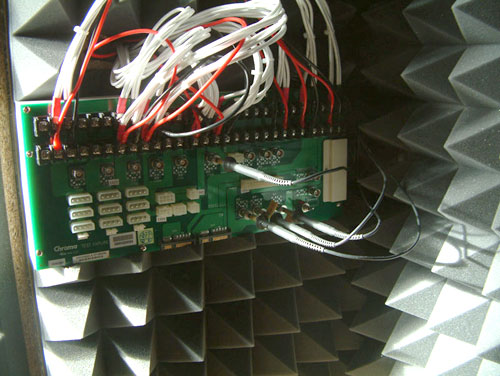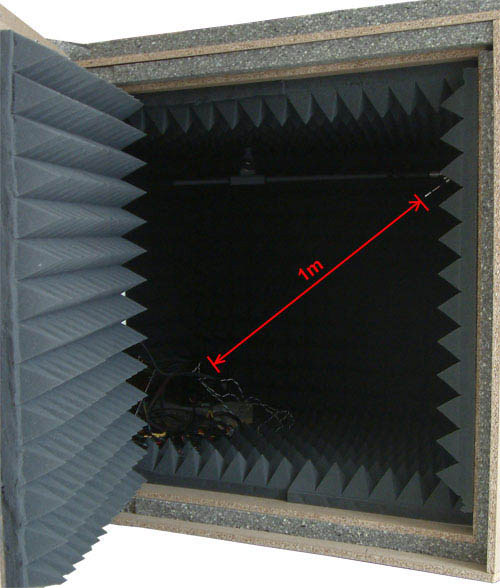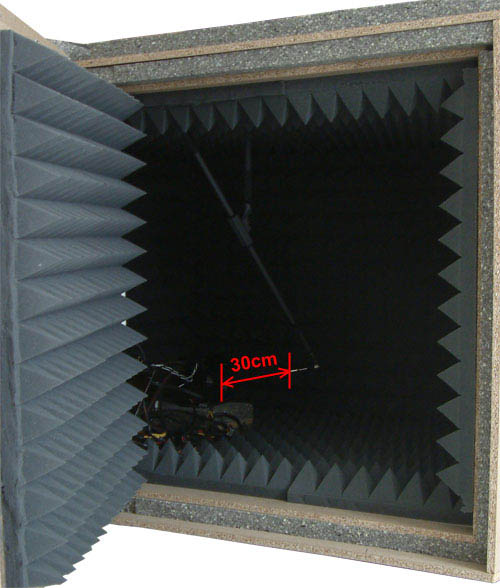AnandTech Power Supply Test Methodology
by Christoph Katzer on July 12, 2007 12:00 AM EST- Posted in
- Cases/Cooling/PSUs
The Testing Environment
There is one flaw in testing power supplies with programmable loads and while trying to test the sound pressure levels at the same time. Because the programmable loads get very loud there is no chance to even hear the power supply on the test stand. In order to make accurate measurements of the noise levels we needed a way to separate the test unit and the programmable loads. Our solution was to build a very thick box around the unit.
We concluded that a five-layer box with a total thickness of 6" (15cm) containing two layers of wood and three layers or special foam would suffice. It is designed as a box within a box. The inner box does not touch any part of the outer box, making it difficult for acoustic noise to pass through in the form of vibration. Each box is isolated on both sides with a layer of heavy foam which is normally used to isolate engines. In the inside we have an additional layer of 4" (10cm) thick pyramidal foam on every side of the box to eliminate the acoustic waves coming from the test object.

To have a completely closed system we installed the printed circuit board to which the connectors of the power supply will be attached inside the anechoic room/box. In other box designs you would need to put all the cables through the wall. Unfortunately that would result in the inside of the box not being totally isolated anymore. Our design keeps everything which needs to be connected inside of the box and maintains isolation.


The microphone hangs on a movable stand which is connected to the roof of the box. With this we can move the microphone around in the box to the position of choice. We measure each unit from two different positions. The first is from 1m distance in conformity with normal measurements. The second position is 30cm in front of the power supply at an angle where the airflow does not interfere with the actual noise measurements.
There is one flaw in testing power supplies with programmable loads and while trying to test the sound pressure levels at the same time. Because the programmable loads get very loud there is no chance to even hear the power supply on the test stand. In order to make accurate measurements of the noise levels we needed a way to separate the test unit and the programmable loads. Our solution was to build a very thick box around the unit.
We concluded that a five-layer box with a total thickness of 6" (15cm) containing two layers of wood and three layers or special foam would suffice. It is designed as a box within a box. The inner box does not touch any part of the outer box, making it difficult for acoustic noise to pass through in the form of vibration. Each box is isolated on both sides with a layer of heavy foam which is normally used to isolate engines. In the inside we have an additional layer of 4" (10cm) thick pyramidal foam on every side of the box to eliminate the acoustic waves coming from the test object.

To have a completely closed system we installed the printed circuit board to which the connectors of the power supply will be attached inside the anechoic room/box. In other box designs you would need to put all the cables through the wall. Unfortunately that would result in the inside of the box not being totally isolated anymore. Our design keeps everything which needs to be connected inside of the box and maintains isolation.


The microphone hangs on a movable stand which is connected to the roof of the box. With this we can move the microphone around in the box to the position of choice. We measure each unit from two different positions. The first is from 1m distance in conformity with normal measurements. The second position is 30cm in front of the power supply at an angle where the airflow does not interfere with the actual noise measurements.










49 Comments
View All Comments
sprockkets - Saturday, July 14, 2007 - link
I've used a kill a watt device to test for pfc, seems most computers are around 0.6 to 0.64. My old Shuttle box with a replaced power supply with active pfc gets a 0.95 pfc.Phlargo - Thursday, July 12, 2007 - link
This is an excellent commitment to a quality review methodology which will not only benefit the Anandtech community, but the whole power supply industry if the message here is taken to heart by consumers. That anandtech has decided to actively create a reliable and consistent power supply review rig is just another example of exactly why I have come to this great site for so many years.Great work!
mostlyprudent - Thursday, July 12, 2007 - link
My thoughts exactly!qpwoei - Thursday, July 12, 2007 - link
How fast can you ramp the current on that rig? I'd be very interested to see how PSUs respond to sudden changes in power usage (caused by sudden changes in CPU/GPU load, HDDs spinning up/down, etc).Even if the fancy equipment can't handle it, measuring this shouldn't be too hard with a cheap digital scope and a 20W passive load. Put the probe on the 12V rail to be measured, attach one end of the load to ground, attach the trigger to the high side of the load, then connect the high side of the load to the 12V rail. Should give a nice edge to trigger on. The trick would be connecting the high side fast enough. A switch/relay would probably be too slow, though a bank of MOSFETS should do the job fine. Actually, the current to turn on the MOSFET bank itself would be a good transient test :)
Also, I think a far more interesting thing with respect to temperature is how the PSU reacts to elevated temperatures, as opposed to temperature WRT load. Since a lot of cheaper PSUs are rated at 20 deg C, I'd expect to see them struggling to supply full power at 40 deg C or so. You'd need to regulate the intake air temperature, but that shouldn't be too hard.
JonnyBlaze - Thursday, July 12, 2007 - link
looks like it can do it.
qpwoei - Friday, July 13, 2007 - link
That's the "mains" supply thing. I noticed that you can read the module number in one of the shots, and it appears that the 63103 can do dynamic load tests - 5 A/us slew with adjustable repetition rates should do the job nicely. I'd be really, really interested to see some results from this.ATWindsor - Thursday, July 12, 2007 - link
Hopefully you will be using the box for some other SPL-measurments on equipment that is not a PSU also?AtW
WW2Planes1 - Thursday, July 12, 2007 - link
Great looking setup. (I love the sound isolating box). I Finally feel like I'll actually learn something from a power supply review.I agree with BladeVenom, I really hope to see some midrange/budget PSUs as well as the higher end ones.
One other thing that would be nice to see in reviews (not just the power supply ones), is longer term reliability. Most things (and especially computer components), aren't really built with longevity in mind, and with certain critical components (power supplies, hard drives, etc) it would be nice to know if certain companies build longer lasting products than others. I understand the difficulties involved with something like that, so I don't really expect to see it, but it would be nice.
TA152H - Thursday, July 12, 2007 - link
I'm not sure midrange or budget power supplies are ever a great idea, unless they are just low power units. A couple of times I bought cases with these power supplies, and was just plopping an old motherboard in it so I didn't care too much, and found they are really problematic. They poison everything downstream from them, which is pretty much everything, and they do nothing good for the reliability of the system, and of course greatly reduce the lifespan of it.The one part of system that should never be compromised on is the power supply. A slower processor or video card might work fine for most people, and if it's not fast enough, it's not catastrophic. A poorly made power supply can have catastrophic consequences and whatever money you save on it, it can cost you later on in multiples of it. You can't make a good power supply out of bad components either, so I don't see how a low cost power supply could impress. Even if it did fairly well in their tests, I'd have serious concerns about the reliability and what will happen to it as time goes along. Low cost power supplies can't be using the same high quality parts, after all.
I'm not knocking power supplies that cost a little because they have relatively low power output. I'm saying if you see an 800 watt power supply that is costing 40% less that other quality 800 watt power supplies with the same feature set, you're asking for trouble buying it. You don't roll dice with power supplies.
Still, it might be interesting just to see the differences quantified, between low and high quality power supplies. I just hope it doesn't lead to people buying the low quality junk. That would be a terrible disservice. It's better to save money on ANY other part of the system before the power supply.
mostlyprudent - Thursday, July 12, 2007 - link
When I think of midrange PSUs, I think of lower wattage models (380-450) by reputable vendors. However, as the article mentions, there are a lot of new players popping up in this market. Hopefully that kind of competition is leading to more competative pricing. It may cease to be true that you need to spend over $100 to get a high quality PSU.My point is that there may be some real value to testing less expensive PSUs.
I get the impression from this article that AT will test a wide range of PSUs (from a wattage standpoint). I hope that is the case. There is nothing more frustrating to me than finding reputable review sites who don't have any recomended PSUs below the 700 watt level.